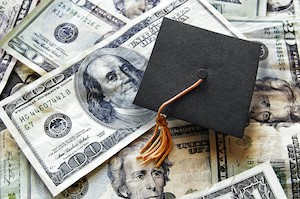After having been paused at the start of the COVID pandemic, federal student loan repayments are set to resume later this year, forcing many to consider cutting back on spending and saving for retirement. 
That apparently is the reality now faced by nearly 44 million federal student loan borrowers whose debt has been put on in forbearance since early 2020 as part of pandemic-relief measures.
In fact, with payments resuming in October after the U.S. Supreme Court ruled against the Biden administration’s student loan forgiveness plan, new research by Empower reveals that 1 in 3 households expect upcoming student loan payments of $1,000 per month.
During the national forbearance, nearly a third (31%) of Americans with student debt say they opted not to make payments on their loans, instead using the reprieve to pay down credit card debt, save up for discretionary spending and build up their emergency savings.
Now, to afford their student loan payments, 32% of Americans say they plan to take on more credit card debt. They also plan to cut back on discretionary spending (59%), dining out (59%), and almost a third (31%) of those surveyed are considering trading in their car and putting off upcoming trips and vacations (41%). To increase savings, 52% of respondents say they are considering switching to a higher paying job and 48% are planning on taking on a side hustle.
And while Empower’s findings do not reveal what impact the loan repayments will have on retirement contributions, data by Fidelity Investments as part of its 2023 College Savings and Student Debt Study shows that more than two-thirds (67%) of recent graduates with student loan debt say their student loan debt is preventing them from participating in major life milestones, like saving for retirement, getting married or buying a home.
Less Disposable Income
Either way, once payments resume, student loan borrowers who did not make payments during the pause are going to have less disposable income available in their budgets. As a result, less money will be available to put toward other financial goals and financial emergencies that may come up, Empower notes.
To that end, Fidelity’s data further shows that roughly two-thirds (65%) of college students taking advantage of the current Federal payment pause say they have no idea how they’re going to start repaying their loans once the emergency pause is lifted this fall.
Industry Help
One area that will be interesting to watch is whether more companies take advantage of the provision in the SECURE 2.0 Act allowing student loan repayments to qualify for employer matches.
Some companies, including Schwab Retirement Plan Services (SRPS), have announced new student loan resources available to 401(k) plan participants to help better manage student loan debt. In Schwab’s latest 401(k) participant survey, more than half of all workers said student loan assistance would be a desirable benefit at work, and nearly a quarter of younger workers said it would be a “must have” benefit if they were looking for a new job.
In addition, Vestwell recently announced that it was acquiring student loan benefits provider Gradifi Solutions to capture a piece of the growing financial wellness market through student loan and college savings options. The acquisition will add several new products to the Vestwell platform, including programs to help employees manage and pay down student debt, contribute to education savings accounts and refinance student loans.
In the meantime, Empower offers a number of suggestions for those who might be among the group whose payments are set to resume in only a few months, including:
- Reviewing repayment plans and alternatives, such as the Biden administration’s recently announced Saving on a Valuable Education Plan, or SAVE, which can reduce payments for low-income earners and waives a portion of interest for borrowers on income-based plans.
- Going back to the basics by taking a look at monthly spending to find places where cuts could be made without impacting long-term goals.
- Considering depositing disposable income in a high-yield cash account in the months left before the payment pause.
- Working student loans into an overall debt payoff strategy, such as the “snowball method” by paying down the lowest balance first, and then move on to bigger loan balances; or the “avalanche method,” in which debt with the highest interest rate is paid off first.
- Weighing debt payoff against other financial goals; if a person can invest in a diversified portfolio with an annualized return that's greater than the interest rate of debt, it may make sense to prioritize investing over paying off debt.
Empower’s findings are based on a survey of 2,210 adults conducted June 28-30, 2023, by Morning Consult on behalf of the firm.
- Log in to post comments
